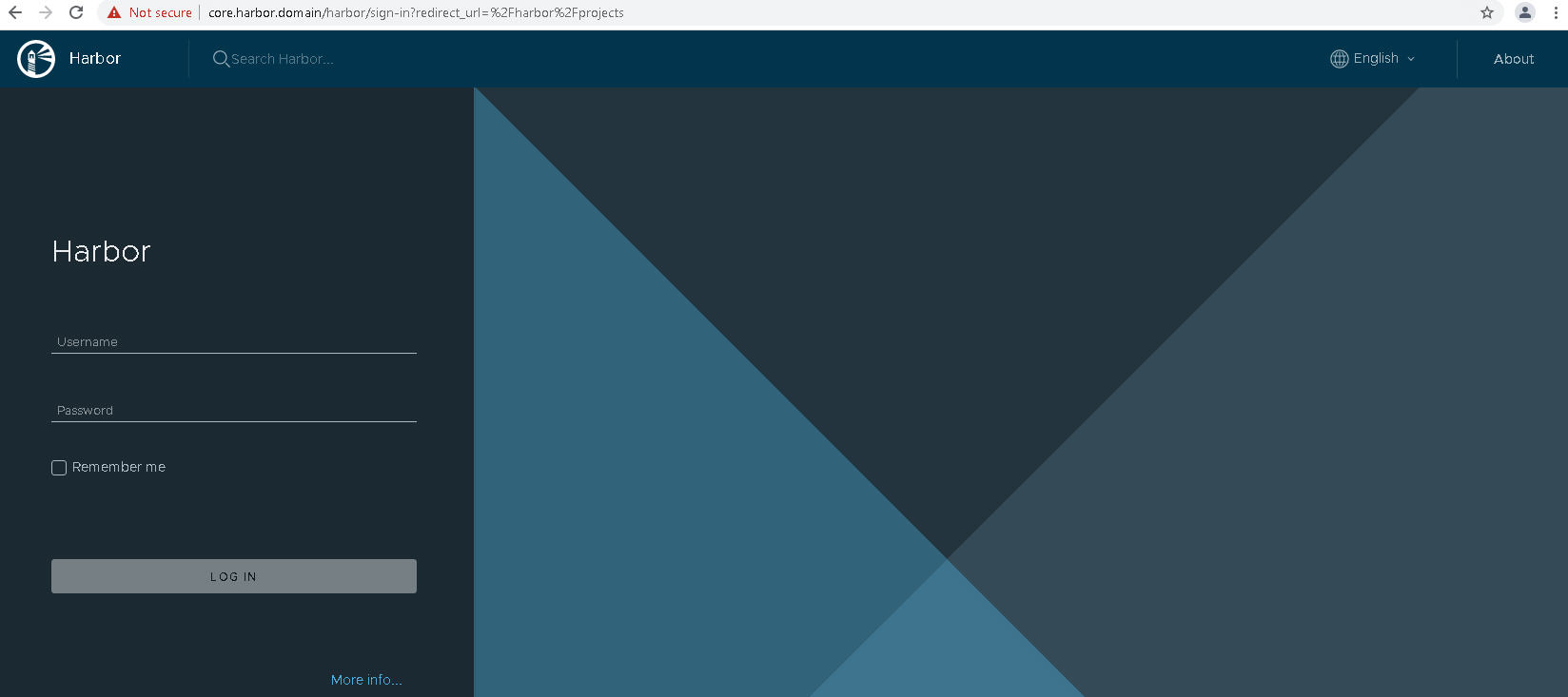Follow these instructions to install Harbor on a TKG cluster provisioned with a TKr for vSphere 7.x.
Prerequisites
See Workflow for Installing Standard Packages on TKr for vSphere 7.x.
- If you are using NSX networking for Supervisor, create an Envoy service of type LoadBalancer.
- If you are using vSphere vDS networking for Supervisor, create an Envoy service of type LoadBalancer or NodePort, depending on your environment and requirements.
In production Harbor requires a DNS Zone on either a local DNS Server, such as BIND, or on a public cloud, such as AWS Route53 or Azure DNS. Once you have set up DNS, to automatically register the Harbor FQDNs with a DNS Server, install the ExternalDNS extension. See Install ExternalDNS on TKr for vSphere 7.x.
Install Harbor
To install the Harbor Registry using the standard package, complete the following steps.
- List the available Harbor versions in the repository.
kubectl get packages -n tkg-system | grep harbor
Create the Harbor Registry namespace.
kubectl create ns tanzu-system-registry
Create the
harbor.yamlspecification.apiVersion: v1 kind: ServiceAccount metadata: name: harbor-sa namespace: tkg-system --- apiVersion: rbac.authorization.k8s.io/v1 kind: ClusterRoleBinding metadata: name: habor-role-binding roleRef: apiGroup: rbac.authorization.k8s.io kind: ClusterRole name: cluster-admin subjects: - kind: ServiceAccount name: harbor-sa namespace: tkg-system --- apiVersion: packaging.carvel.dev/v1alpha1 kind: PackageInstall metadata: name: harbor namespace: tkg-system spec: serviceAccountName: harbor-sa packageRef: refName: harbor.tanzu.vmware.com versionSelection: constraints: 2.7.1+vmware.1-tkg.1 #PKG-VERSION values: - secretRef: name: harbor-data-values --- apiVersion: v1 kind: Secret metadata: name: harbor-data-values namespace: harbor-registry stringData: values.yml: | namespace: tanzu-system-registry hostname: <ENTER-HARBOR-FQDN> port: https: 443 logLevel: info tlsCertificate: tls.crt: "" tls.key: "" ca.crt: tlsCertificateSecretName: enableContourHttpProxy: true harborAdminPassword: <ENTER-STRONG-PASSWORD-HERE> secretKey: <ENTER-SECRET-KEY> database: password: <ENTER-STRONG-PASSWORD-HERE> shmSizeLimit: maxIdleConns: maxOpenConns: exporter: cacheDuration: core: replicas: 1 secret: <ENTER-SECRET> xsrfKey: <ENTER-XSRF-KEY-WHICH-IS-AN-ALPHANUMERIC-STRING-WITH-32-CHARS> jobservice: replicas: 1 secret: <ENTER-SECRET> registry: replicas: 1 secret: <ENTER-SECRET> trivy: enabled: true replicas: 1 gitHubToken: "" skipUpdate: false persistence: persistentVolumeClaim: registry: existingClaim: "" storageClass: "<ENTER-STORAGE-CLASS>" subPath: "" accessMode: ReadWriteOnce size: 50Gi jobservice: existingClaim: "" storageClass: "<ENTER-STORAGE-CLASS>" subPath: "" accessMode: ReadWriteOnce size: 10Gi database: existingClaim: "" storageClass: "<ENTER-STORAGE-CLASS>" subPath: "" accessMode: ReadWriteOnce size: 10Gi redis: existingClaim: "" storageClass: "<ENTER-STORAGE-CLASS>" subPath: "" accessMode: ReadWriteOnce size: 10Gi trivy: existingClaim: "" storageClass: "<ENTER-STORAGE-CLASS>" subPath: "" accessMode: ReadWriteOnce size: 10Gi proxy: httpProxy: httpsProxy: noProxy: 127.0.0.1,localhost,.local,.internal pspNames: vmware-system-restricted network: ipFamilies: ["IPv4", "IPv6"]- Customize the
harbor-data-valuessecret in theharbor.yamlspecification with appropriate values for your environment, including hostname, passwords, secrets, and storage class.Refer to Harbor Package Reference for guidance.
- Install Harbor.
kubectl apply -f harbor.yaml
- Verify Harbor installation.
kubectl get all -n tanzu-system-registry
Configure DNS for Harbor Using an Envoy LoadBalancer (NSX Networking)
- Get the
External-IPaddress for the Envoy service of type LoadBalancer.kubectl get service envoy -n tanzu-system-ingress
You should see theExternal-IPaddress returned, for example:NAME TYPE CLUSTER-IP EXTERNAL-IP PORT(S) AGE envoy LoadBalancer 10.99.25.220 10.195.141.17 80:30437/TCP,443:30589/TCP 3h27m
Alternatively you can get theExternal-IPaddress using the following command.kubectl get svc envoy -n tanzu-system-ingress -o jsonpath='{.status.loadBalancer.ingress[0]}' - To verify the installation of the Harbor extension, update your local
/etc/hostsfile with the Harbor and Notary FQDNs mapped to theExternal-IPaddress of the load balancer, for example:127.0.0.1 localhost 127.0.1.1 ubuntu #TKG Harbor with Envoy Load Balancer IP 10.195.141.17 core.harbor.domain 10.195.141.17 core.notary.harbor.domain
- To verify the installation of the Harbor extension, log in to Harbor.
- Create two CNAME records on a DNS server that map the Envoy service Load Balancer
External-IPaddress to the Harbor FQDN and the Notary FQDN. - Install the External DNS extension.
Configure DNS for Harbor Using an Envoy NodePort (vDS Networking)
port.https value in the
harbor-data-values.yaml file.
- Switch context to the vSphere Namespace where the cluster is provisioned.
kubectl config use-context VSPHERE-NAMESPACE
- List the nodes in the cluster.
kubectl get virtualmachines
- Pick one of the worker nodes and describe it using the following command.
kubectl describe virtualmachines tkg2-cluster-X-workers-9twdr-59bc54dc97-kt4cm
- Locate the IP address of the virtual machine, for example
Vm Ip: 10.115.22.43. - To verify the installation of the Harbor extension, update your local
/etc/hostsfile with the Harbor and Notary FQDNs mapped to the worker node IP address, for example:127.0.0.1 localhost 127.0.1.1 ubuntu #TKG Harbor with Envoy NodePort 10.115.22.43 core.harbor.domain 10.115.22.43 core.notary.harbor.domain
- To verify the installation of the Harbor extension, log in to Harbor.
- Create two CNAME records on a DNS server that map the worker node IP address to the Harbor FQDN and the Notary FQDN.
- Install the External DNS extension.
Log In to the Harbor Web Interface
- Access the Harbor Registry web interface at
https://core.harbor.domain, or the hostname you used.
- Log in to Harbor with the username admin and the generated password that you put in the
harbor-data-values.yamlfile.
- Verify that you can access the Harbor user interface.

- Obtain the Harbor CA certificate.
In the Harbor interface, select , or create a New Project.
Click Registry Certificate and download the Harbor CA certificate (ca.crt).
- Add the Harbor CA certificate into the trust store of Docker client so you can push and pull container images to and from the Harbor Registry. See Using Private Registries with TKG Service Clusters.
- Refer to the Harbor documentation for details on using Harbor.